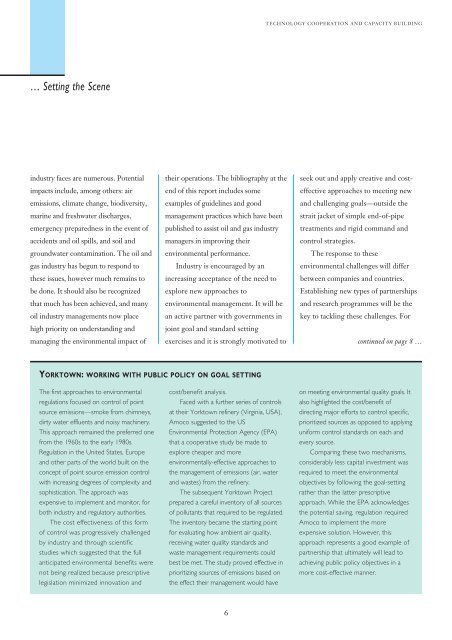Technology Cooperation and Capacity Building - CommDev
Technology Cooperation and Capacity Building - CommDev
Technology Cooperation and Capacity Building - CommDev
Create successful ePaper yourself
Turn your PDF publications into a flip-book with our unique Google optimized e-Paper software.
TECHNOLOGY COOPERATION AND CAPACITY BUILDING… Setting the Sceneindustry faces are numerous. Potentialimpacts include, among others: airemissions, climate change, biodiversity,marine <strong>and</strong> freshwater discharges,emergency preparedness in the event ofaccidents <strong>and</strong> oil spills, <strong>and</strong> soil <strong>and</strong>groundwater contamination. The oil <strong>and</strong>gas industry has begun to respond tothese issues, however much remains tobe done. It should also be recognizedthat much has been achieved, <strong>and</strong> manyoil industry managements now placehigh priority on underst<strong>and</strong>ing <strong>and</strong>managing the environmental impact oftheir operations. The bibliography at theend of this report includes someexamples of guidelines <strong>and</strong> goodmanagement practices which have beenpublished to assist oil <strong>and</strong> gas industrymanagers in improving theirenvironmental performance.Industry is encouraged by anincreasing acceptance of the need toexplore new approaches toenvironmental management. It will bean active partner with governments injoint goal <strong>and</strong> st<strong>and</strong>ard settingexercises <strong>and</strong> it is strongly motivated toseek out <strong>and</strong> apply creative <strong>and</strong> costeffectiveapproaches to meeting new<strong>and</strong> challenging goals—outside thestrait jacket of simple end-of-pipetreatments <strong>and</strong> rigid comm<strong>and</strong> <strong>and</strong>control strategies.The response to theseenvironmental challenges will differbetween companies <strong>and</strong> countries.Establishing new types of partnerships<strong>and</strong> research programmes will be thekey to tackling these challenges. Forcontinued on page 8 …YORKTOWN: WORKING WITH PUBLIC POLICY ON GOAL SETTINGThe first approaches to environmentalregulations focused on control of pointsource emissions—smoke from chimneys,dirty water effluents <strong>and</strong> noisy machinery.This approach remained the preferred onefrom the 1960s to the early 1980s.Regulation in the United States, Europe<strong>and</strong> other parts of the world built on theconcept of point source emission controlwith increasing degrees of complexity <strong>and</strong>sophistication. The approach wasexpensive to implement <strong>and</strong> monitor, forboth industry <strong>and</strong> regulatory authorities.The cost effectiveness of this formof control was progressively challengedby industry <strong>and</strong> through scientificstudies which suggested that the fullanticipated environmental benefits werenot being realized because prescriptivelegislation minimized innovation <strong>and</strong>cost/benefit analysis.Faced with a further series of controlsat their Yorktown refinery (Virginia, USA),Amoco suggested to the USEnvironmental Protection Agency (EPA)that a cooperative study be made toexplore cheaper <strong>and</strong> moreenvironmentally-effective approaches tothe management of emissions (air, water<strong>and</strong> wastes) from the refinery.The subsequent Yorktown Projectprepared a careful inventory of all sourcesof pollutants that required to be regulated.The inventory became the starting pointfor evaluating how ambient air quality,receiving water quality st<strong>and</strong>ards <strong>and</strong>waste management requirements couldbest be met. The study proved effective inprioritizing sources of emissions based onthe effect their management would haveon meeting environmental quality goals. Italso highlighted the cost/benefit ofdirecting major efforts to control specific,prioritized sources as opposed to applyinguniform control st<strong>and</strong>ards on each <strong>and</strong>every source.Comparing these two mechanisms,considerably less capital investment wasrequired to meet the environmentalobjectives by following the goal-settingrather than the latter prescriptiveapproach. While the EPA acknowledgesthe potential saving, regulation requiredAmoco to implement the moreexpensive solution. However, thisapproach represents a good example ofpartnership that ultimately will lead toachieving public policy objectives in amore cost-effective manner.6















![[PDF] Community Development Toolkit - CommDev](https://img.yumpu.com/48616495/1/184x260/pdf-community-development-toolkit-commdev.jpg?quality=85)
